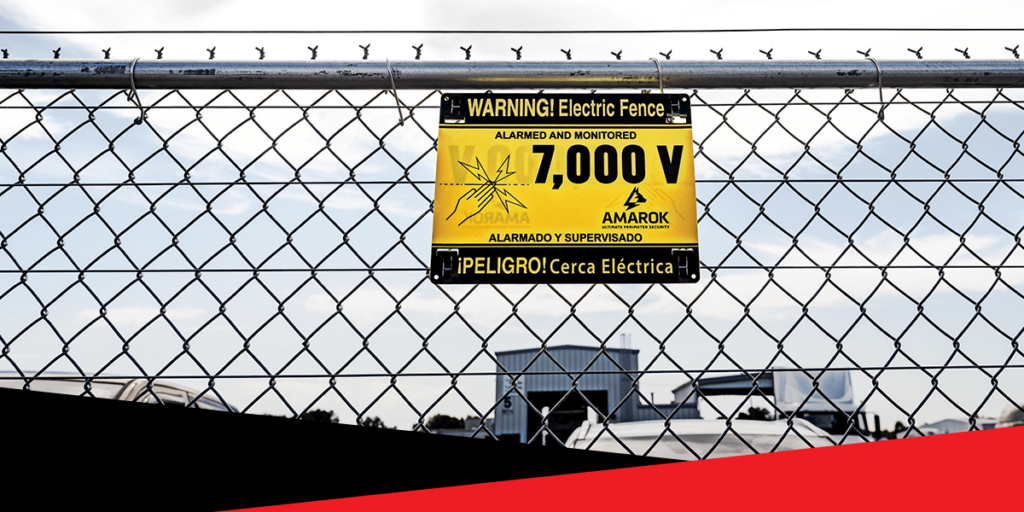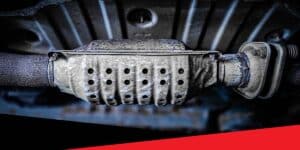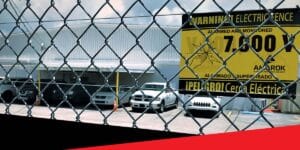Catalytic converters prevent excess emissions from damaging the environment and reducing air quality. They’re also valuable and attractive targets for thieves. These components contain precious metals like palladium and rhodium that can fetch hundreds of dollars through illegal resale. It’s quick money for a generally untraceable car part — it takes an average of only five minutes to remove one and even less for experienced criminals.
Catalytic converter theft occurs at businesses nationwide, yet some areas have an increased risk. Learning more about the issue’s importance, where it’s most frequent, and why can help you mitigate your risk through proactive security strategies.
Why an Increased Risk of Catalytic Converter Theft Matters for Your Bottom Line
While converter theft may net criminals a few hundred dollars, the true costs of the crime are higher. The more likely an event is in your area, the higher your risk for more impact on your company’s bottom line.
Immediate Impacts
The theft of a catalytic converter means vehicle repairs are needed immediately. While the vehicle may still be drivable, operating it without the part on public roadways is illegal and can result in fines. The repairs, including parts and labor, can range into the thousands. Vehicle owners may also have to pay these costs out of pocket — only comprehensive policies will reimburse owners for the loss.
Following an incident, vehicle owners or fleet managers may spend hours filing insurance claims and securing rentals if necessary. Each hour devoted to those tasks takes time away from focusing on business growth and revenue. Lengthy waits for repairs are also common. Converter theft growth over the past several years and supply chain disruptions have impacted parts availability, with many repairs taking weeks.
Mid-Term Impacts
Even with comprehensive insurance, there’s no guarantee the insurance company will honor your claim. Carriers have several options for denying claims, and business owners may be left absorbing the costs without the right documentation or coverage. If the carrier does pay the claim, financial consequences may still arise. The insurer may significantly increase premiums or opt to cancel the policy, leaving businesses to find coverage elsewhere.
Time becomes a key factor here, too. Vehicles that are in the garage awaiting repair for weeks aren’t generating revenue for your company or helping keep your employees productive.
Long-Term Impacts
Customers depend on certain businesses, like airport parking providers and auto repair service shops, to protect vehicles from theft. Customer confidence decreases if their assets are stolen while entrusted to your care. They may share the news with others, damaging your company’s reputation and ability to grow. Converter thefts can also make existing or potential customers choose competitors for future needs, reducing your business’s long-term revenue growth and competitiveness.
States With High Catalytic Converter Theft
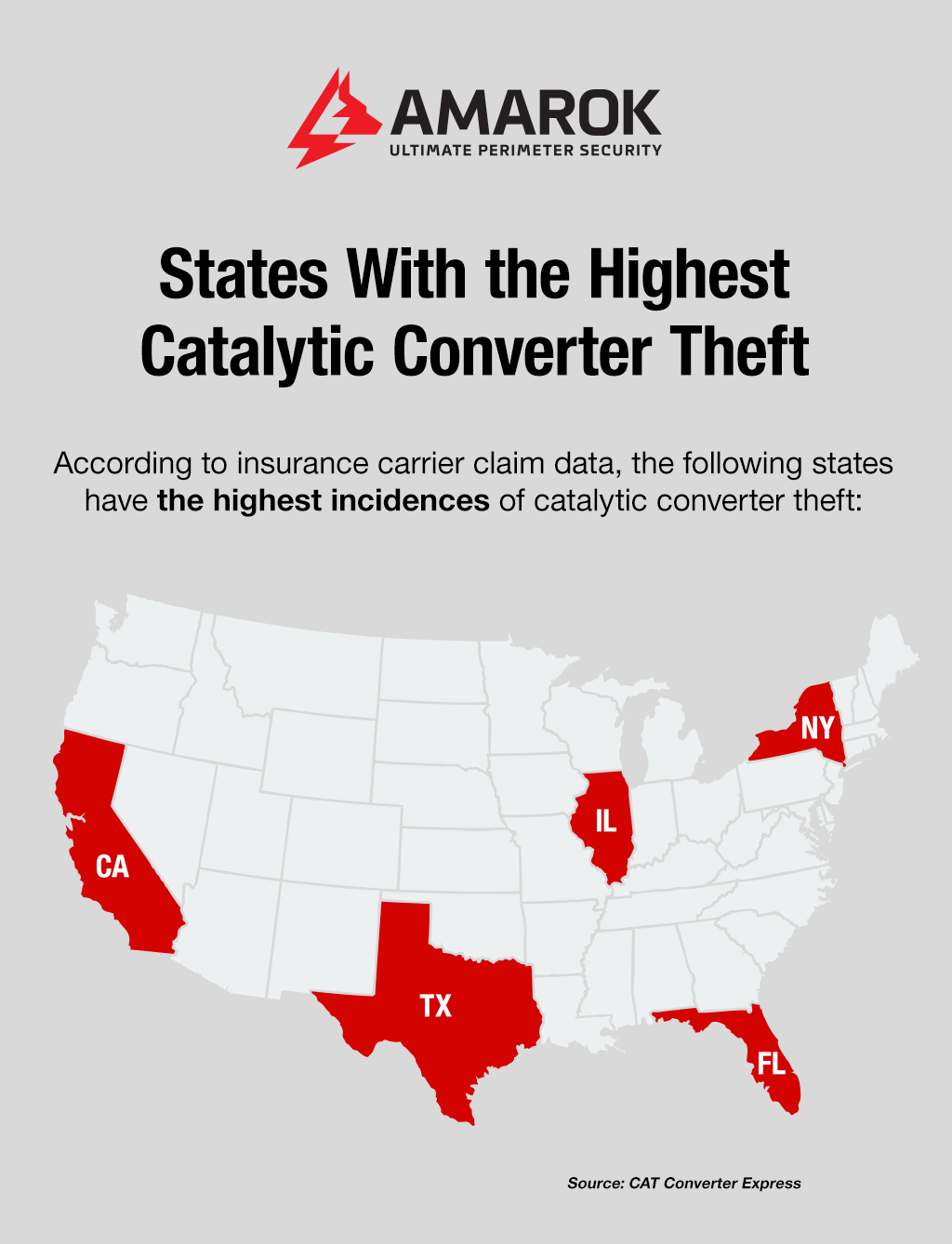
According to insurance carrier claim data, here are the highest catalytic converter thefts by state:
Cities With High Catalytic Converter Theft
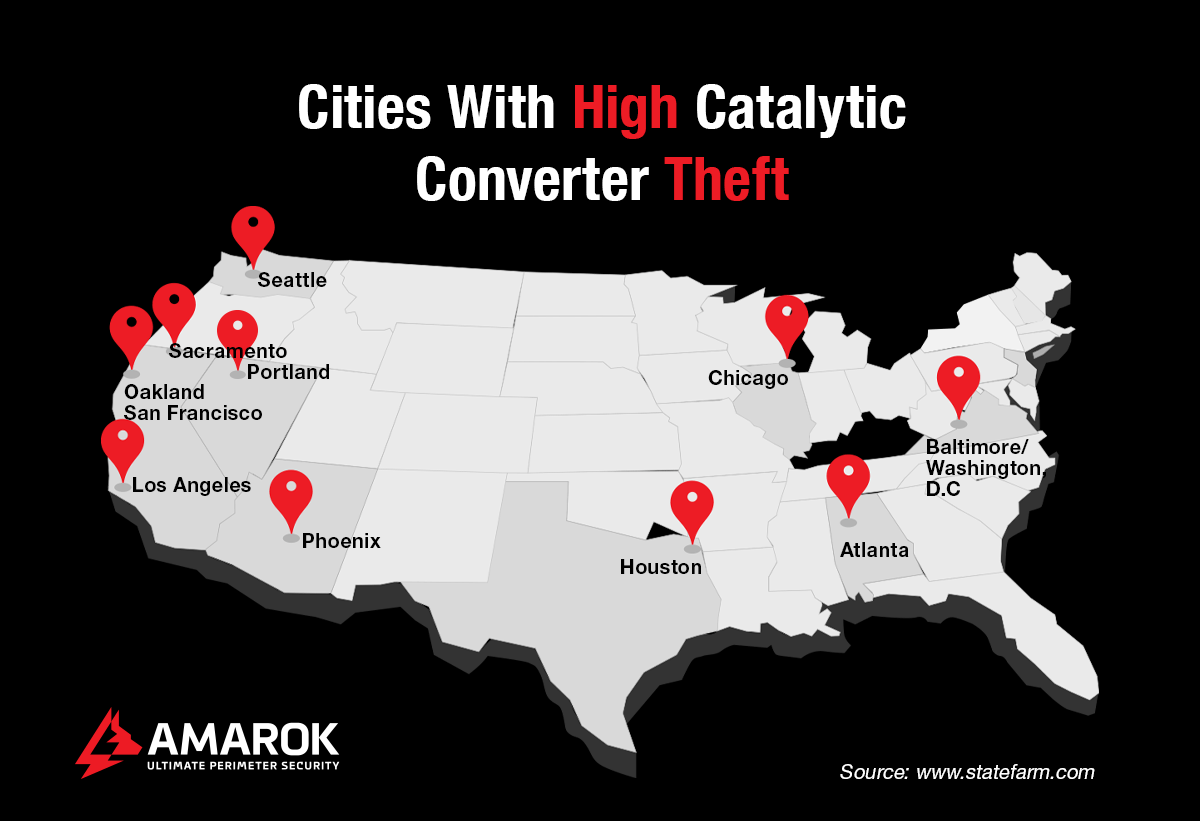
Insurance data ranks the following cities as highest in catalytic converter thefts by city:
- Los Angeles
- Houston
- Oakland/San Francisco
- Chicago
- Baltimore/Washington, D.C.
- Atlanta
- Phoenix
- Portland
- Seattle
- Sacramento
Why Do Certain Cities Have More Catalytic Converter Theft?
There are several reasons why some cities see more catalytic converter theft than others.
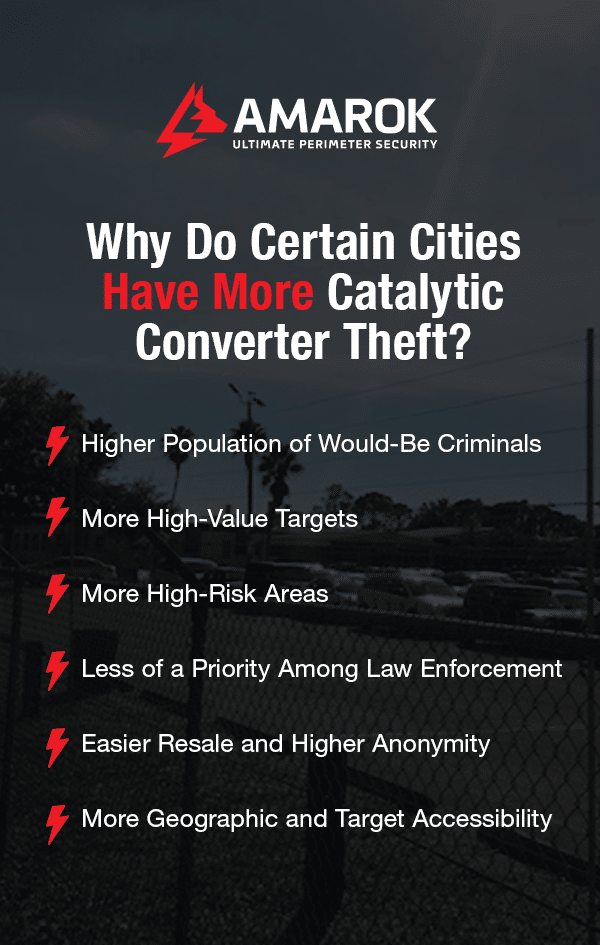
Higher Population of Would-Be Criminals
Urban areas are naturally more heavily populated. With this increase in people comes a corresponding rise in the potential for illegal activity.
Statistics are limited on the number of catalytic converter thefts per 100,000 people. Making the issue more complex is that many thefts likely go unreported since not every insurance policy covers the loss.
However, we can examine the incarceration rate to better understand the impact of more people on crime. The U.S. ranks third in the world with 531 inmates per 100,000 individuals, or about five incarcerated individuals for every 100 people. A city with a population of 1 million could conceivably expect 5,310 people to engage in some form of criminal activity.
More High-Value Targets
The types of vehicles that your fleet contains or your customers drive can create a higher risk for converter thefts.
For example, trucks and SUVs have more ground clearance, making it easier to get beneath them to remove the component. Larger models and those with dual exhaust systems may contain up to four catalytic converters, boosting the overall payout for a single incident. As a result, businesses with a higher number of larger vehicles — like trucking companies within high-risk cities — naturally see increased converter theft.
Catalytic converters from hybrids and newer vehicles are in higher demand. Their energy-efficient design may rely on more rare metal content or dual converters. Components may also be in better condition with reduced exposure to harmful emissions. These characteristics typically mean higher resale prices, raising the risk in metropolitan areas where hybrid vehicles are more popular.
The most frequently targeted vehicles nationwide include:
- Ford F-150
- Ford Explorer
- Honda Accord
- Toyota Prius
- Honda CR-V
- Chevrolet Equinox
- Toyota Tacoma
- Kia Soul
- Chevrolet Traverse
- Chevrolet Cruze
The list changes slightly in different regions. In the west, two Subaru models and the Toyota Camry rank among the top 10. Similarly, the Ford Expedition joins the ranks in the Southwest and Southeast with the biggest year-over-year jump in the rankings.
More High-Risk Areas
With a population increase comes higher-density occupancy and major transportation hubs. Large, open parking lots or unsecured parking garages are common. A property without a robust perimeter security strategy provides numerous options for criminals within an easily accessible area.
In the same vein, metropolitan areas are often home to many construction sites and expansive industrial parks. These areas are often dark and unattended after business hours. Companies with vehicle fleets, challenging-to-secure locations, and few observers nearby make attractive targets for converter theft, increasing risks in these city areas.
Less of a Priority Among Law Enforcement
Cities must prioritize their assets, regardless of the size of their law enforcement teams. As a result, high-profile incidents or violent crime often get more time, attention, and resources. The police and justice system may not prioritize apprehending, prosecuting, or penalizing converter theft.
Additionally, converter theft victims may be less likely to report the crime. They may feel it’s undervalued by law enforcement or that a response will take excess time due to limited officer availability. A lack of insurance coverage may also influence their decision not to report the incident. Both raise risks since criminals are then more likely to attempt and continue profiting from the theft.
Easier Resale and Higher Anonymity
Urban proximity to more people and more metal recycling businesses creates more potential outlets for resale. It’s simpler and faster for thieves to find a ready buyer, then disappear with the cash. Similarly, large crowds of people common in metropolitan areas make it simple for thieves to blend in. It may also be more challenging for witnesses and observers to describe the thief to law enforcement personnel.
More Geographic and Target Accessibility
Cities typically feature a vast highway system with multiple entries and exits. This translates into fast, easy escapes after a theft.
Targets may also be more accessible in certain areas of the country. For example, people are more likely to park their vehicles outside when it’s warm and sunny. The larger number of desirable targets can mean higher theft risk in cities with milder climates.
A similar issue may exist when the non-resident population is high. Commuters, tourists, students, and visiting businesspeople may all temporarily bring additional vehicles within city limits, boosting the choices for opportunistic thieves. Many of these people may use less secure parking options for economic reasons. It’s also common for non-residents to lack familiarity with which areas are higher risk, increasing converter theft in certain cities.
What Can I Do if I’m a Business Owner in an Area With Higher Converter Theft?
Fortunately, organizations can take a few key steps to safeguard themselves in areas with high catalytic converter theft.
Engage With Your Community
Collaborating with community members is an effective way to bolster security and mitigate crime risks. Consider options to engage nearby businesses, residents, and law enforcement in community-wide crime prevention, such as:
- Forming a neighborhood watch
- Offering free catalytic converter vehicle identification number (VIN) etching
- Educating metal recycling centers in the area about risks
- Implementing an open communication strategy to share information
You can also connect with your local government representatives and lobby for legal changes to crack down on converter theft. Many states, including Missouri, Ohio, and Washington, have proposed or passed legislation to combat the crime through various measures. Often, these bills require buyers to verify the seller’s identity and ownership of the vehicle the converter came from. Some also impose harsher criminal penalties on offenders to dissuade them from converter theft.
Analyze Your Property Risks
Not every business is equally vulnerable to catalytic converter theft.
Your property’s geography is one determinant of its risks. The layout, on-site structures, and physical features can affect the ease of access. For example, converter theft risk increases if a criminal can climb nearby vegetation to breach your perimeter.
The business type also significantly impacts risk potential. Companies with larger vehicle fleets that are more challenging to secure during off-hours are more likely to become targets. As a result, theft risk rises for organizations like car rental facilities and auto auctions.
A reputable security expert can conduct a threat assessment to help you determine your specific risks.
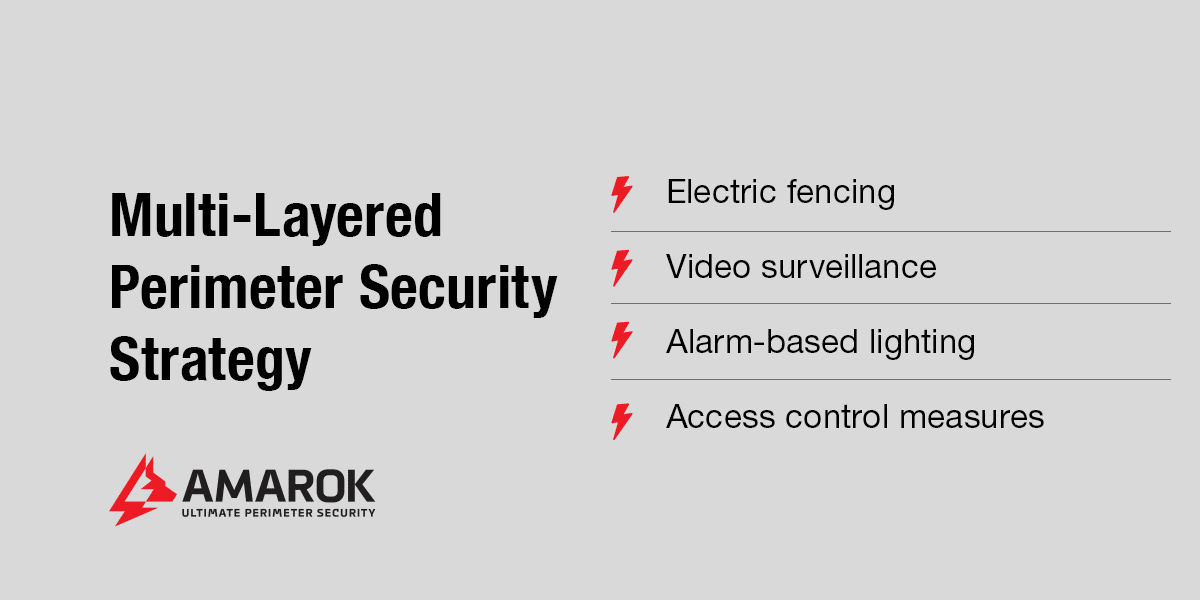
Design a Perimeter Security Plan to Stop Attempted Property Breaches
Once you know your unique vulnerabilities, leverage those insights to close your security gaps with a multi-layered perimeter security strategy. This approach is the most effective solution for deterring, detecting, and delaying crime.
The best way to stop external theft is to prevent criminals from accessing your property at the perimeter. Physical barriers like an electric fence are a primary defense since they are both a visual deterrent and an impediment against unauthorized entry. This fencing delivers a safe but memorable shock to thieves who contact it. AMAROK’s electric fencing delivers a pulsed electric shock every 1.3 seconds, which makes it safe.
Electric fences seamlessly integrate with additional security measures for unified, comprehensive protection. Examples include:
- Video surveillance: Cameras alone can’t stop crime, but they’re essential for capturing video evidence and having visibility over your entire perimeter. Combine these with around-the-clock expert monitoring for greater peace of mind than on-site security guards can offer.
- Alarm-based lighting: Perimeter security measures that incorporate lights and sirens call unwanted attention to would-be thieves when an alarm is triggered. The sirens and lights help deter them and encourage them to abandon their activities.
- Access control measures: Make entry and exit points as secure as the rest of your physical barrier with Gate Access Control to keep intruders from breaching.
Partner With AMAROK — The Smarter Approach to Perimeter Security
AMAROK is the nationwide leader in effective electric fencing for commercial and industrial properties. We help over 8,000+ companies stop 99% of external theft with The Electric Guard Dog™ Fence, our flagship full-perimeter electric fence. This physical barrier delivers a safe but memorable pulsed shock to would-be intruders.
Our electric fencing and other integrated perimeter security solutions provide cost-effective security confidence with security-as-a-service pricing. There are no upfront costs — you pay a single monthly subscription fee that includes any system maintenance and repairs completed by our highly skilled technicians. Plus, the average AMAROK customer saves $120,000 annually when they replace 24/7 security guards with our system.
Join the growing number of businesses successfully safeguarding critical assets with the ultimate perimeter security solution. Find your local AMAROK security expert or reach out for details on how we can help.
